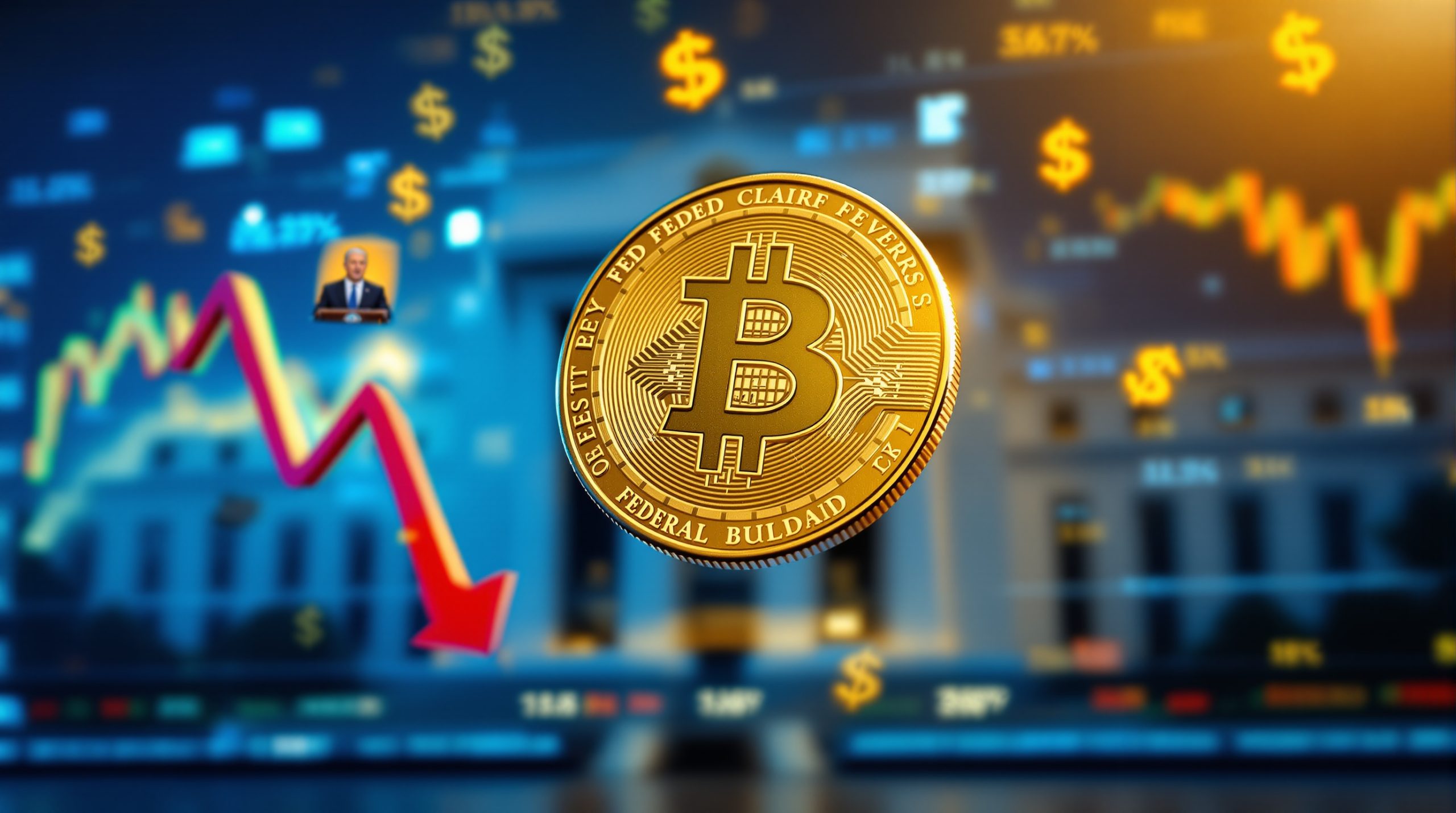The Unexpected Gold Market Reaction to September's Monetary Policy Decision Gold prices experienced a surprising pullback following the Federal Reserve's interest rate cut in September, leaving many investors puzzled. Despite reaching an all-time high of $3,707.40 per ounce immediately after the announcement, prices quickly retreated to around $3,657, marking a notable decline from the record peak. This counterintuitive market reaction highlights the complex relationship between monetary policy decisions and precious metals markets. While conventional wisdom suggests gold should rally when interest rates fall, the reality often proves more nuanced. What Drives Gold's Counterintuitive Price Action? The Fed's Cautious Approach to Rate Cuts The Federal Reserve implemented a modest 25 basis point rate reduction, bringing the benchmark rate down from its previous level. However, rather than signaling an aggressive easing cycle, Chair Powell characterized the action as a "risk-management cut" primarily responding to weakening labor market conditions. This cautious framing disappointed investors who had anticipated a more dovish outlook. The measured tone suggested a gradual approach to monetary easing rather than the accelerated path many gold bulls had hoped for. Historical data from the Federal Reserve Bank of St. Louis shows that gold typically performs best when policymakers signal a sustained easing cycle rather than isolated rate adjustments. The market's reaction reflected disappointment in the limited scope of potential future cuts. Market Expectations vs. Fed Reality Many traders had already positioned themselves for not just the September cut but also accelerated easing through year-end. When the Fed's Summary of Economic Projections revealed a more gradual approach to future cuts, this created a disconnect between market expectations and the Fed's actual intentions. The World Gold Council's research indicates that gold markets often "buy the rumor, sell the fact" around monetary policy decisions. This pattern manifests when traders build positions ahead of anticipated events and then take profits once the news materializes. Financial analysts note that gold futures trading volume typically increases 200-300% on Fed decision days, according to CME Group data. This heightened activity creates volatility that can overwhelm the fundamental relationship between interest rates and gold prices in the short term. The Critical Dollar Relationship The U.S. dollar index, which had initially dipped to a 3.5-year low following the rate announcement, rebounded after Powell's press conference. This dollar strengthening applied downward pressure on gold prices, as the two typically maintain an inverse relationship. Gold's correlation with the U.S. Dollar Index historically ranges from -0.7 to -0.8 during rate cut cycles, according to market research. When the dollar strengthens, gold becomes more expensive for holders of other currencies, potentially reducing demand. Currency market dynamics extend beyond just the dollar. Major central banks worldwide maintain differing monetary policy stances, creating a complex global environment that influences precious metals pricing through multiple currency channels. How Economic Factors Shaped the Fed's Decision Labor Market Concerns Powell emphasized that weakening employment data served as the primary catalyst for initiating rate cuts. The labor market showed signs of cooling that warranted a policy response despite ongoing inflation concerns. Job growth trends had decelerated in recent months, creating the unusual situation where the Fed began cutting rates while inflation remained above target. This divergence from historical patterns created uncertainty that contributed to gold's volatile price action. Labor market indicators serve as leading signals for monetary policy shifts. Gold investors closely monitor employment reports for early signs of economic weakness that might accelerate the Fed's easing cycle. Persistent Inflation Challenges Powell emphasized that inflation remains "somewhat elevated" despite progress toward the Fed's 2% target. This ongoing inflation concern prevented the Fed from adopting a more aggressive easing stance, which would typically be more supportive for gold prices. Research shows that gold performs best when real interest rates (nominal rates minus inflation) turn negative. The World Gold Council's analysis indicates gold typically outperforms when real rates fall below -2%, as this reduces the opportunity cost of holding non-yielding assets. The delicate balance between addressing labor market weakness while remaining vigilant about inflation hedge dynamics created mixed signals that contributed to gold's price volatility following the announcement. Growth Outlook Considerations Economic indicators presented a mixed picture, with certain sectors showing resilience while others displayed weakness. This uneven growth landscape contributed to the Fed's measured approach to monetary easing. Consumer spending patterns had remained relatively robust despite higher interest rates, allowing the Fed to proceed cautiously rather than implementing aggressive cuts that would typically benefit gold more substantially. Business investment trends showed signs of caution, with companies delaying major capital expenditures amid uncertainty about future economic conditions. This hesitancy factored into the Fed's decision-making process while creating an ambiguous environment for gold investors. Technical Analysis of Gold's Price Movement Chart Patterns and Key Levels Despite the pullback, gold maintained support above the psychologically important $3,600 level. Technical analysts note that the metal remains in an overall uptrend, with the recent high establishing a new resistance level for future price action. Volume analysis reveals unusually high trading activity immediately following the Fed announcement, indicating significant institutional repositioning rather than retail investor activity. This volume spike often signifies a temporary exhaustion of buying pressure. Momentum indicators showed signs of overextension prior to the Fed decision, with relative strength readings approaching overbought territory. This technical vulnerability contributed to the sharp reversal despite the fundamentally supportive rate cut. Institutional Positioning Shifts SPDR Gold Trust, the world's largest gold-backed exchange-traded fund, reported a 0.44% decrease in holdings to 975.66 tonnes following the Fed decision. This reduction reflects institutional repositioning in response to the price action. ETF flows serve as a critical barometer of institutional sentiment toward gold. The reduction in holdings suggests that some large investors viewed the Fed's measured tone as a reason to reduce exposure temporarily. Commitment of Traders data from regulated futures markets provides additional insight into how various market participants adjusted their gold positions following the announcement. Commercial hedgers, speculative funds, and retail traders often respond differently to Fed policy shifts. Retail Sentiment Indicators Retail demand indicators show continued interest in physical gold despite the price volatility. Many individual investors view pullbacks as potential buying opportunities within the context of the longer-term uptrend. Physical premiums for coins and small bars provide insight into retail demand patterns. These premiums often increase during price dips as individual investors seize opportunities to accumulate physical metal at lower prices. Social media sentiment analysis reveals growing interest in gold investment among retail traders, particularly as economic uncertainty persists. This grassroots demand provides underlying support for prices despite institutional fluctuations. Investment Implications for Different Market Participants Portfolio Managers' Perspective Asset allocation specialists recommend maintaining strategic gold positions rather than attempting to time short-term price movements around Fed decisions. The metal's diversification benefits often prove most valuable during periods of market turbulence. Research from major financial institutions suggests a 5-10% gold allocation can enhance portfolio stability while potentially improving risk-adjusted returns over complete economic cycles. This strategic approach contrasts with tactical trading around Fed announcements. Alternative precious metals like silver often display different volatility profiles during rate cut cycles. Portfolio managers frequently evaluate relative value opportunities across the precious metals complex rather than focusing exclusively on gold. Mining Sector Impact Gold producer stocks typically exhibit leverage to underlying metal prices, both on the upside and downside. The post-Fed price action created volatility in mining equities as investors reassessed profit margin expectations. Production cost margins remain healthy for most major miners at current price levels, with all-in sustaining costs averaging $1,200-1,500 per ounce for larger producers. This cost structure provides substantial profitability even if gold experiences further short-term weakness. Exploration and development projects face different economic considerations from operating mines. Junior mining companies focused on exploration often experience amplified volatility during periods of gold price uncertainty. Retail Investor Strategies Dollar-cost averaging offers a disciplined approach for retail investors seeking gold exposure without attempting to time market movements. This strategy involves making regular purchases regardless of price, reducing the impact of short-term volatility. Physical ownership versus ETF investment represents a fundamental decision for retail gold investors. Physical metal provides advantages during extreme market stress but carries storage costs and liquidity considerations that ETFs avoid. Tax implications vary significantly across different gold investment strategies. Physical metals, ETFs, mining stocks, and futures contracts each receive distinct tax treatment that can meaningfully impact after-tax returns. Historical Context: Gold During Rate-Cutting Cycles Performance Patterns in Previous Easing Periods Statistical analysis of previous Fed easing cycles shows gold typically delivers positive returns over the full duration of rate cut periods. During the 2019-2020 easing cycle, gold rose approximately 25% as the Fed cut rates from 2.5% to near zero. The timing of performance often follows a pattern where initial market reactions may be mixed while longer-term trends more closely correlate with the direction of real interest rates. This suggests patience may reward gold investors despite short-term volatility. Gold's correlation with other asset classes tends to decrease during easing cycles, enhancing its portfolio diversification benefits precisely when they prove most valuable. This relationship becomes particularly significant during periods of financial stress. Unique Aspects of the Current Cycle The current environment differs from previous easing cycles due to the combination of still-elevated inflation, a cooling labor market, and starting from historically high interest rate levels. These unique circumstances complicate historical comparisons. Global monetary policy divergence creates additional complexity for gold markets. While the Fed begins cutting rates, other major central banks maintain different policy trajectories, creating cross-currents in currency markets that influence gold pricing. Geopolitical tensions provide a backdrop of uncertainty that typically supports safe-haven demand for gold. These non-monetary factors can amplify or counteract interest rate effects depending on their severity and market outlook insights. What's Next for Gold Prices? Short-Term Price Catalysts Upcoming economic data releases will heavily influence both Fed policy expectations and gold price movements. Employment reports, inflation readings, and manufacturing indices deserve particular attention from gold investors. Technical levels established during the post-Fed volatility will likely influence near-term trading patterns. The previous all-time high around $3,707 now represents significant resistance while the $3,600 level provides important psychological support. Options market positioning reveals increased volatility expectations through year-end. The pricing of gold options suggests traders anticipate continued large price swings as markets digest changing Fed policy expectations, according to Reuters' recent coverage. Medium-Term Outlook Factors The projected Fed rate path through year-end remains a critical determinant for gold prices. Markets currently price a 90% probability of another 25 basis point cut at the Fed's October meeting, creating potential for either confirmation or disappointment. Inflation trajectory expectations significantly influence gold's medium-term prospects. If inflation proves persistent despite rate cuts, this could create the negative real interest rate environment that historically benefits gold most substantially. Central bank gold purchasing trends provide underlying support for prices. Central banks added approximately 650-700 tonnes annually to their reserves in recent years, creating consistent demand independent of interest rate fluctuations. Long-Term Fundamental Considerations Structural drivers for gold extend well beyond short-term monetary policy decisions. Long-term factors including sovereign debt levels, currency debasement concerns, and wealth preservation motives influence strategic gold investment demand. Supply constraints from major producing regions continue to emerge as grades decline and discovery rates fall. Gold mine production has plateaued in recent years despite higher prices, suggesting limited supply elasticity. Environmental regulations increasingly impact mining economics, with stricter permitting requirements and sustainability standards adding to production costs. These regulatory trends contribute to gold's long-term supply-demand fundamentals. FAQ: Gold Investing After the Fed Decision How does gold typically perform after the first rate cut? Historical performance data shows gold typically delivers stronger returns over the 12-24 months following the initiation of rate cut cycles compared to immediate post-announcement periods. This suggests investors should maintain longer time horizons rather than reacting to short-term volatility. The magnitude of performance varies significantly based on concurrent economic conditions. Gold performs best when rate cuts coincide with economic uncertainty rather than "insurance cuts" made during otherwise strong economic conditions. Other precious metals often display different timing patterns during easing cycles. Silver typically lags gold initially but frequently outperforms during the later stages of easing periods as industrial demand components respond to economic stimulus. What economic indicators should gold investors monitor closely? Employment data deserves particular attention as labor market weakness prompted the initial rate cut. The monthly jobs report, weekly unemployment claims, and labor force participation rates provide critical insights into potential Fed policy acceleration. Inflation metrics including the Consumer Price Index, Personal Consumption Expenditures, and various inflation expectation surveys directly influence real interest rate calculations that historically correlate strongly with gold performance. Consumer confidence measures affect safe-haven demand dynamics. Deteriorating sentiment often corresponds with increased interest in defensive assets including gold, creating demand independent of interest rate considerations. How might different Fed scenarios affect gold through year-end? Accelerated rate cuts would likely provide stronger support for gold prices by reducing opportunity costs more rapidly. This scenario would most likely emerge if labor market deterioration accelerates beyond current expectations. Paused or slower-than-expected easing would probably create headwinds for gold in the near term. If the Fed maintains its measured approach despite market expectations for faster cuts, this could strengthen the dollar and pressure gold. Changing inflation projections significantly influence gold's prospects regardless of the precise rate path. Rising inflation expectations coupled with rate cuts create the negative real rate environment most conducive to gold appreciation. What role do geopolitical factors play alongside monetary policy? Current global tensions create an underlying bid for safe-haven assets including gold. These non-monetary drivers can temporarily override interest rate considerations during periods of heightened uncertainty. Regional conflicts impact gold through multiple channels beyond risk sentiment. Supply chain disruptions, energy price effects on inflation, and currency market repercussions all influence gold through different mechanisms. Election cycles introduce additional policy uncertainty that typically supports gold demand. Market participants often increase defensive positioning ahead of major electoral events that could shift economic policy directions. Expert Perspectives on Gold's Future Direction Market Strategist Viewpoints Many professional analysts maintain constructive outlooks on gold despite short-term volatility following the Fed decision. The consensus view emphasizes the metal's potential benefits during periods of economic transition and policy uncertainty. The contrasting bearish case focuses on potential dollar strength if the Fed maintains a more hawkish stance than other major central banks. Currency dynamics could create headwinds for gold despite nominally lower interest rates. Price targets for different timeframes show significant divergence. Near-term forecast & momentum projections cluster around the $3,500-3,800 range while longer-term projections extend considerably higher based on real interest rate expectations and structural demand factors. Technical Analyst Forecasts Pattern completion projections suggest the recent pullback represents a normal correction within an ongoing uptrend. Technical analysts note that bull markets typically experience several 5-10% corrections during extended advances. Fibonacci retracement analysis identifies key support levels derived from the recent advance. The 38.2% retracement level often provides meaningful support during bull market corrections and would correspond to prices near the $3,550 area. Relative strength comparisons with other assets show gold maintaining superior momentum despite the post-Fed volatility. This technical resilience suggests underlying strength that could reassert itself once the initial disappointment fades, as noted in recent analysis by Kitco. Gold's price action following the rate cut demonstrates the complex interplay between monetary policy, market expectations, and technical factors. While conventional wisdom suggests falling interest rates benefit precious metals, the reality proves considerably more nuanced. Investors should recognize that short-term price movements often reflect positioning adjustments and profit-taking rather than fundamental shifts in gold's longer-term outlook. Historical analysis indicates that patience typically rewards gold investors during rate-cutting cycles despite initial volatility. The post-Fed gold price decline after Fed rate cut reinforces the importance of maintaining strategic allocations rather than attempting to time short-term fluctuations. Gold's diversification benefits and record high analysis remain intact regardless of day-to-day price movements following policy announcements. Want to Profit from the Next Major Gold Discovery? Don't miss out on substantial returns from early-stage mineral discoveries on the ASX. Visit Discovery Alert's dedicated discoveries page to see how their proprietary Discovery IQ model helps investors identify significant gold opportunities before the broader market recognises their potential.

Gold Price Decline After Fed Rate Cut: What Happened?
Discover why gold prices unexpectedly declined after the Fed’s rate



